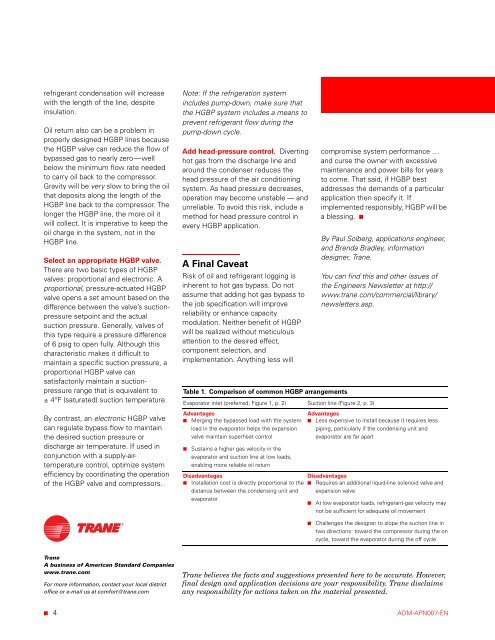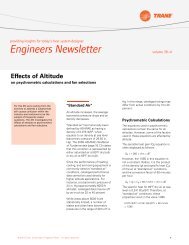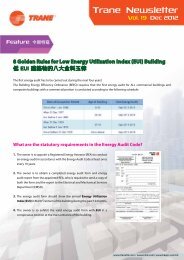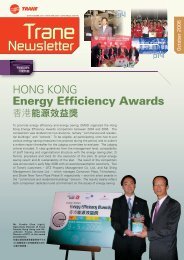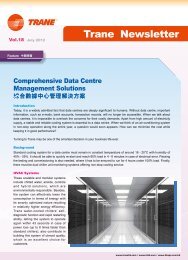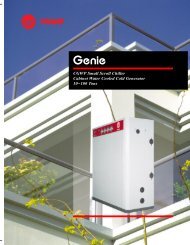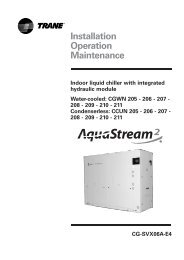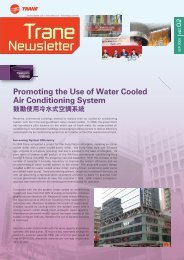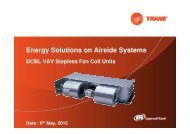Trane Engineers Newsletter, volume 32-2
Trane Engineers Newsletter, volume 32-2
Trane Engineers Newsletter, volume 32-2
- No tags were found...
Create successful ePaper yourself
Turn your PDF publications into a flip-book with our unique Google optimized e-Paper software.
efrigerant condensation will increasewith the length of the line, despiteinsulation.Oil return also can be a problem inproperly designed HGBP lines becausethe HGBP valve can reduce the flow ofbypassed gas to nearly zero—wellbelow the minimum flow rate neededto carry oil back to the compressor.Gravity will be very slow to bring the oilthat deposits along the length of theHGBP line back to the compressor. Thelonger the HGBP line, the more oil itwill collect. It is imperative to keep theoil charge in the system, not in theHGBP line.Select an appropriate HGBP valve.There are two basic types of HGBPvalves: proportional and electronic. Aproportional, pressure-actuated HGBPvalve opens a set amount based on thedifference between the valve’s suctionpressuresetpoint and the actualsuction pressure. Generally, valves ofthis type require a pressure differenceof 6 psig to open fully. Although thischaracteristic makes it difficult tomaintain a specific suction pressure, aproportional HGBP valve cansatisfactorily maintain a suctionpressurerange that is equivalent to± 4°F (saturated) suction temperature.By contrast, an electronic HGBP valvecan regulate bypass flow to maintainthe desired suction pressure ordischarge air temperature. If used inconjunction with a supply-airtemperaturecontrol, optimize systemefficiency by coordinating the operationof the HGBP valve and compressors.Note: If the refrigeration systemincludes pump-down, make sure thatthe HGBP system includes a means toprevent refrigerant flow during thepump-down cycle.Add head-pressure control. Divertinghot gas from the discharge line andaround the condenser reduces thehead pressure of the air conditioningsystem. As head pressure decreases,operation may become unstable — andunreliable. To avoid this risk, include amethod for head pressure control inevery HGBP application.A Final CaveatRisk of oil and refrigerant logging isinherent to hot gas bypass. Do notassume that adding hot gas bypass tothe job specification will improvereliability or enhance capacitymodulation. Neither benefit of HGBPwill be realized without meticulousattention to the desired effect,component selection, andimplementation. Anything less willTable 1. Comparison of common HGBP arrangementsEvaporator inlet (preferred; Figure 1, p. 2) Suction line (Figure 2, p. 3)Advantages■ Merging the bypassed load with the systemload in the evaporator helps the expansionvalve maintain superheat control■Sustains a higher gas velocity in theevaporator and suction line at low loads,enabling more reliable oil returnDisadvantages■ Installation cost is directly proportional to thedistance between the condensing unit andevaporatorcompromise system performance …and curse the owner with excessivemaintenance and power bills for yearsto come. That said, if HGBP bestaddresses the demands of a particularapplication then specify it. Ifimplemented responsibly, HGBP will bea blessing. ■By Paul Solberg, applications engineer,and Brenda Bradley, informationdesigner, <strong>Trane</strong>.You can find this and other issues ofthe <strong>Engineers</strong> <strong>Newsletter</strong> at http://www.trane.com/commercial/library/newsletters.asp.Advantages■ Less expensive to install because it requires lesspiping, particularly if the condensing unit andevaporator are far apartDisadvantages■ Requires an additional liquid-line solenoid valve andexpansion valve■At low evaporator loads, refrigerant-gas velocity maynot be sufficient for adequate oil movement■ Challenges the designer to slope the suction line intwo directions: toward the compressor during the oncycle, toward the evaporator during the off cycle<strong>Trane</strong>A business of American Standard Companieswww.trane.comFor more information, contact your local districtoffice or e-mail us at comfort@trane.com<strong>Trane</strong> believes the facts and suggestions presented here to be accurate. However,final design and application decisions are your responsibility. <strong>Trane</strong> disclaimsany responsibility for actions taken on the material presented.■ 4 ADM-APN007-EN


